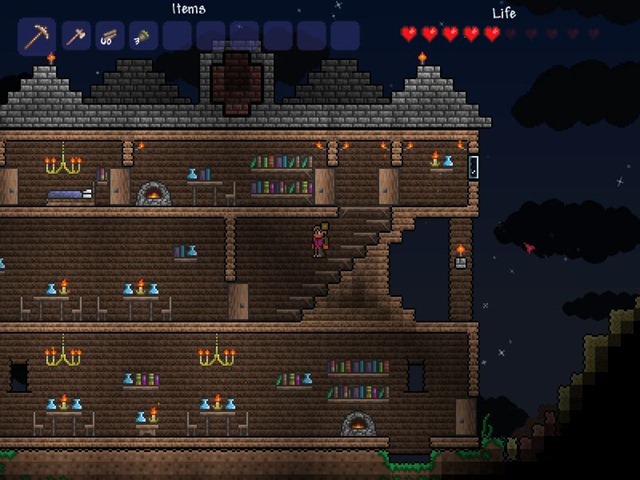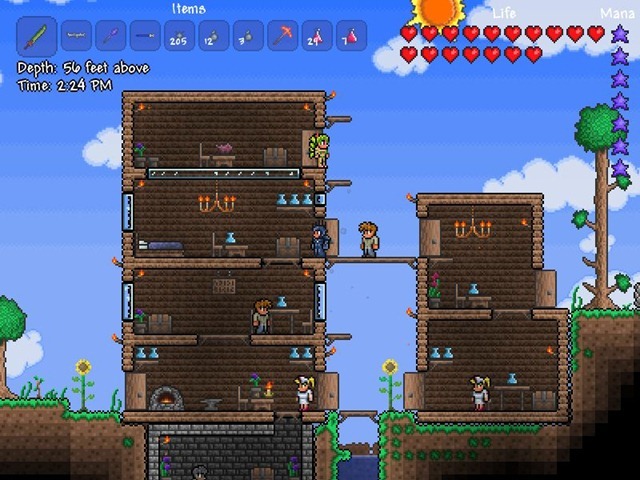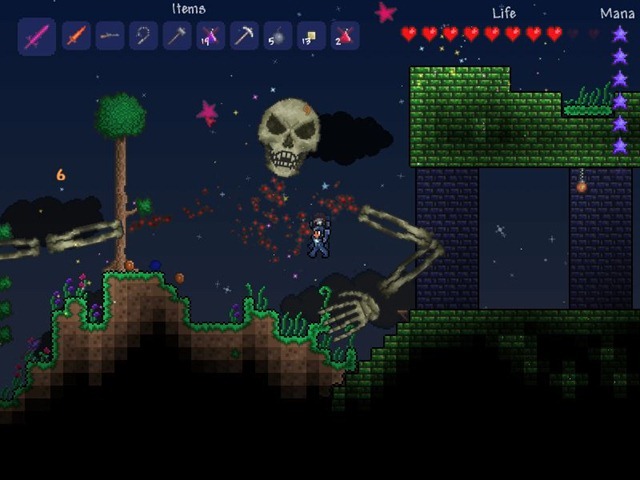Terraria is a game that lives in the virtual filing cabinet of my mind under the headings “Indie”, “Awesome”, “Retro” and “Like Minecraft” (which I’ll come to soon). In other words, it’s ticking all the right boxes, with the right coloured pen.
But what can we, as pen-and-pencil role-playing gamers learn from this wonderful Indie hit?
Well, I’ll tell you.
Similarity is not a bad thing
I’ll start with the obvious one first. As soon as you mention Terraria, someone else immediately says “but it’s like Minecraft!”. It’s a reflex action. That should be Terraria’s tagline, right there on the website. “Terraria, but it’s like Minecraft!” it could proudly announce to all and sundry. Wear it like a badge of honour, because being like something that’s freakin’ awesome is far from a bad thing.
There’s no doubting that Terraria wouldn’t even exist if it wasn’t for Minecraft. Who would have thought that in this Ultra-HD gaming culture where every single blade of grass contains a higher poly-count than last year’s character models there was room for games where blockiness is not only accepted, but lauded as a feature. Games where building and exploration is the focus, rather than the size of your gun or how far you can get through a pre-defined path-locked linear map.
Except that saying Terraria is like Minecraft is only telling 10% of the story. It is something said by people who are either repeating what they have heard, repeating a poorly written review, or have played for less than 10 minutes before giving in. Because yes, for those first few minutes, Terraria is very like Minecraft indeed. You cut down trees. You mine. You build a house and hide from Zombies. That’s Minecraft-like, right there.
After that, things get… well, pretty crazy.
Terraria is like Minecraft, but it also has similarities to Metroid, Super Mario, Castlevania and a whole host of other classic games. It is all of those, and more, dropped into a blender and poured over ice. While Terraria lacks Minecraft’s sense of exploration and wonderment, it fills that space with lasers and rocket boots. So it’s all good.
Likewise, every edition of D&D (including Pathfinder) is similar, but different. Each one brings something unique to the mix. They all share a common root, but it’s the differences that draw their respective fans. Some gamers love the way Pathfinder works, while others prefer 4e. It’s the same with AD&D, Classic D&D and Third Edition. Just because you favour one doesn’t mean the others are bad. Unless you’re an asshole of course. Sad to say there’s a lot of them about these days, and they’re doing nothing but denigrate the hobby they claim to enjoy. Personally, I have no time for them.
It’s the same with Minecraft and Terraria. Even though it’s Minecraft I tend to play the most, I love ‘em both.
Shiny toys are a measure of advancement
When you begin to play Terraria, you only have the basics: wooden axe, hatchet, sword, etc. It’s the equivalent to your 1st level character’s starting equipment – basic, but functional.
Pretty soon you get enough Iron to make an Anvil, and enough Stone to create a Furnace. From there, the world is your lobster. Donning your first set of Copper Armour (yes, really) is a milestone in the game. As is your first Iron Broadsword, Space Gun and Demon Bow. Your hero can make (or buy, or trade) new shinies for himself as he progresses through the game. That’s especially useful when playing Multi Player as you’ll immediately know that the dude with the Rocket Boots, Space Gun and Meteor Armour isn’t to be messed with.
Yet when it comes to our RPGs, we treat Equipment like they’re an unloved thing. We talk about Magic Item Dependency and how the game engine uses Magic Items to make up for the shortfalls in the underlying mathematics. At best, Magic Items are a kludgy solution, and at worst they’re a problem in themselves. This is a far cry from what they should be – awesome shiny stuff that let the player boast “Look at my character! He’s wearing the Diamond Armour of Grax! That’s how badass he is!”
What’s the solution to this? Another blogpost for another time. I look forward to your comments and suggestions.
A sandbox full of character-driven plotlines
Damn. Way too descriptive a subheading. Ah well, best to roll with it now.
Terraria is a sandbox full of character-driven plotlines. If you want your dude (or dudess) to battle wave after wave of Zombies, he can. If you want to build the highest tower or plunge the deepest depths, go for it. If you want to fight back the Corruption, create a waterworld or do any one of a thousand other things, then you can. The hero is the plot.
A good sandbox rpg campaign should be just like that. The PCs are the plot. The adventures span outward from their backstories and what they want their heroes to do. The key to that is in encouraging the players to make characters they are genuinely excited about. If your adventuring party is made up of Blort the Fourth, Gizzard the Wizard and St Elsewhere the Cleric, you can kiss your serious epic Sandbox campaign goodbye.
If, on the other hand, you can coax your players to make a character who is the great-grandson of Virrax the Necromancer who terrorised the region a hundred years ago and whose name is still used to scare children, or a Rogue who is secretly the Prince of a neighbouring kingdom on the run from his Princely duties – then you’ve got plotline potential, right there.
Single Player. Multi Player. Same game, different feel
Playing Terraria in Single Player mode is great fun. The world is entirely yours to build, explore and destroy according your your whims, and yours alone.
But you could argue that the game plays at its best when playing Multi Player where there’s a whole host of other players all with different (and potentially conflicting) interest and agendas. Terraria even includes an optional Player-versus-Player mode where players can choose sides for full-on rivalries and deathmatches. If you want that kind of thing.
Role-playing games generally default to what PC gamers would call “Cooperative Multi Player Mode” in that the players are all working together to achieve a common goal. I have played many a superhero session in what they’d call “Single Player Mode” too where it’s just one GM and a lone player. Superhero gaming is fantastic for solo gaming because you can throw the spotlight directly on the hero and craft villains, scenarios and whole settings tailor-made just for him. If the player creates Batman, you can give him Gotham, The Joker and the Batcave. If he’s more of a Daredevil type, set it in Hell’s Kitchen against Bullseye and Kingpin. As a GM, solo gaming gives you the freedom to focus tightly on just one character without worrying that the other PCs will get bored.
It’s also fun to switch gears occasionally. If your regular D&D group can’t make the session but the Cleric player can, why not run a solo scenario just for him that involves Temple Politics and a murder in the vestry? If it’s the Rogue player, set him up with something involving the local Thieve’s Guild. Or whatever. What you’re doing is grounding the PC in his world beyond that of the adventuring party. And that’s always a good thing.
I could go on. I could talk about how Terraria is an example of Better Through Simplification. I could show you the monsters. I could write about how Exploration is it’s own reward. But I’m not going to. Why not find out all these things – and more – for yourself?
Terraria is available via Steam for just $9.99 (or £5.99 in real money). And it’s worth every penny (or cent). Go get it!








I’ve been working on a pathfinder campaign lately based on Terraria:
http://symptomsofmadness.blogspot.com/search/label/notes%3A
Oh, excellent!